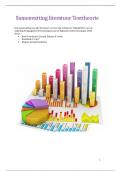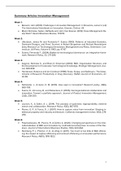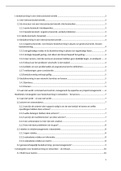MACRO 6
GLOBALISATION
What is globalisation?
Globalisation is a process by which economies and cultures have been
drawn deeper together and become more inter connected through
global networks of trade, capital flows, and the rapid spread of
technology and global media
From an economic perspective it can be defined as the ever increasing
integration of the world’s local, regional and national economies into a
single international market
Economic integration can be broken down into four main areas:
o Free trade across national boundaries of goods and services
o Free movement of labour between countries in the same way
there is free movement of labour within the UK
o Free movement of capital between countries so a US company can
buy a UK company
o Free interchange of technology and intellectual capital across
national boundaries
A completely globalised world is where there aren’t any boundaries to
trade in goods and services and there is perfect free movement of
labour, capital and technology
In present day many boundaries still exist
A narrowly localised world is where people live in villages and towns,
trade is the exception, people don’t move from village to village and
there is no exchange of capital or technology
The share of global GDP accounted for by exports of goods and services
have risen from 12% in 1960 to almost 30% now
Key characteristics of globalisation include:
Trade ratios are increasing for most countries
Expansion of financial capital flows between countries
Foreign direct investment and cross border M&A
Rising number of global brands including emerging countries
Deeper specialisation of labour – components come from many nations
Global supply chains and new trade and investment routes
o E.g. south – south trade
Increasing levels of international labour migration and migration within
countries
, Increasing connectivity of people and businesses through mobile and
Wifi networks
Causes of globalisation
Many of the factors are interlinked and it is a combination of factors
which causes globalisation
Trade in goods
o For rich developed countries goods are increasingly being
manufactured abroad in developing countries
o Developing countries are acquiring the capital and equipment
o There are more efficient modes of transport to get goods to
markets
o Developing countries have the cost advantage of cheap labour
Trade in services
o This is growing
o Growth in tourism is taking large numbers of visitors abroad
o Call centres for customers are being located in developing
countries (e.g. India)
Trade liberalisation
o This is a reason for trade in goods and services growing
o Lower protectionist barriers have encouraged growth in world
trade
MNCs and TNCs
o These have grown inn number and in size
o They may have monopoly power in markets and can engage in
illegal anti-competitive practices
o They can also influence government decisions because they have
the skills and money to lobby governments and they promise large
investments or threats of disinvestment
International financial flows
o These are increasing rapidly
o Countries such as China and Malaysia have financed part of their
fast economic growth from inward flows of international capital
Key drivers of globalisation
Containerisation
The costs of ocean shipping have come down due to
containerisation, bulk shipping and other production efficiencies
Technological change
GLOBALISATION
What is globalisation?
Globalisation is a process by which economies and cultures have been
drawn deeper together and become more inter connected through
global networks of trade, capital flows, and the rapid spread of
technology and global media
From an economic perspective it can be defined as the ever increasing
integration of the world’s local, regional and national economies into a
single international market
Economic integration can be broken down into four main areas:
o Free trade across national boundaries of goods and services
o Free movement of labour between countries in the same way
there is free movement of labour within the UK
o Free movement of capital between countries so a US company can
buy a UK company
o Free interchange of technology and intellectual capital across
national boundaries
A completely globalised world is where there aren’t any boundaries to
trade in goods and services and there is perfect free movement of
labour, capital and technology
In present day many boundaries still exist
A narrowly localised world is where people live in villages and towns,
trade is the exception, people don’t move from village to village and
there is no exchange of capital or technology
The share of global GDP accounted for by exports of goods and services
have risen from 12% in 1960 to almost 30% now
Key characteristics of globalisation include:
Trade ratios are increasing for most countries
Expansion of financial capital flows between countries
Foreign direct investment and cross border M&A
Rising number of global brands including emerging countries
Deeper specialisation of labour – components come from many nations
Global supply chains and new trade and investment routes
o E.g. south – south trade
Increasing levels of international labour migration and migration within
countries
, Increasing connectivity of people and businesses through mobile and
Wifi networks
Causes of globalisation
Many of the factors are interlinked and it is a combination of factors
which causes globalisation
Trade in goods
o For rich developed countries goods are increasingly being
manufactured abroad in developing countries
o Developing countries are acquiring the capital and equipment
o There are more efficient modes of transport to get goods to
markets
o Developing countries have the cost advantage of cheap labour
Trade in services
o This is growing
o Growth in tourism is taking large numbers of visitors abroad
o Call centres for customers are being located in developing
countries (e.g. India)
Trade liberalisation
o This is a reason for trade in goods and services growing
o Lower protectionist barriers have encouraged growth in world
trade
MNCs and TNCs
o These have grown inn number and in size
o They may have monopoly power in markets and can engage in
illegal anti-competitive practices
o They can also influence government decisions because they have
the skills and money to lobby governments and they promise large
investments or threats of disinvestment
International financial flows
o These are increasing rapidly
o Countries such as China and Malaysia have financed part of their
fast economic growth from inward flows of international capital
Key drivers of globalisation
Containerisation
The costs of ocean shipping have come down due to
containerisation, bulk shipping and other production efficiencies
Technological change











